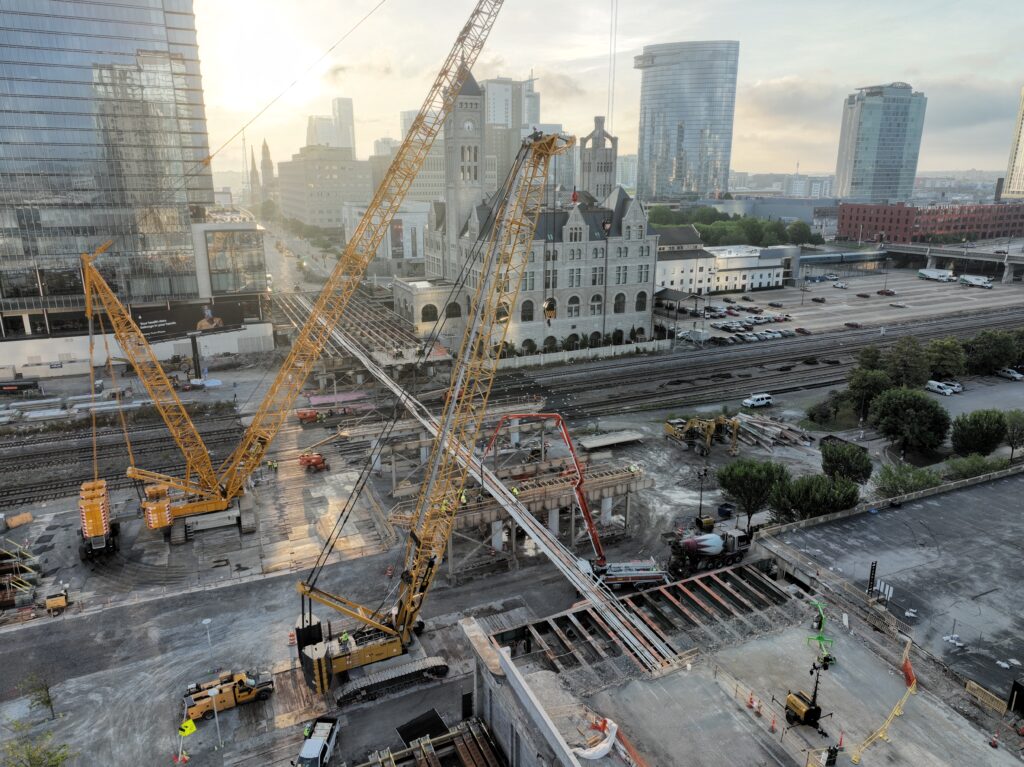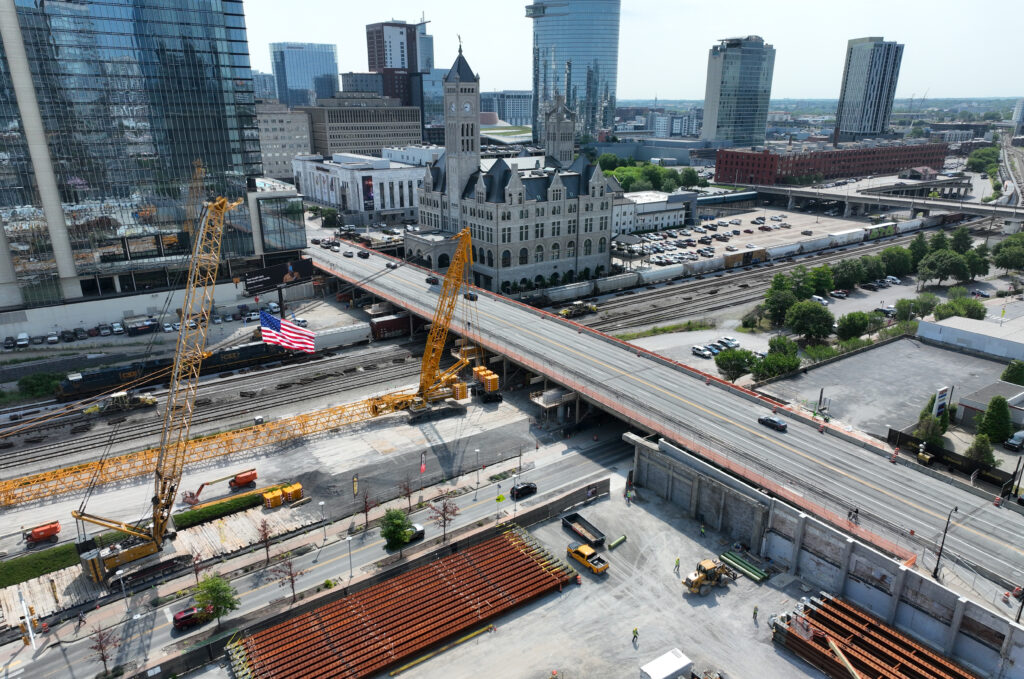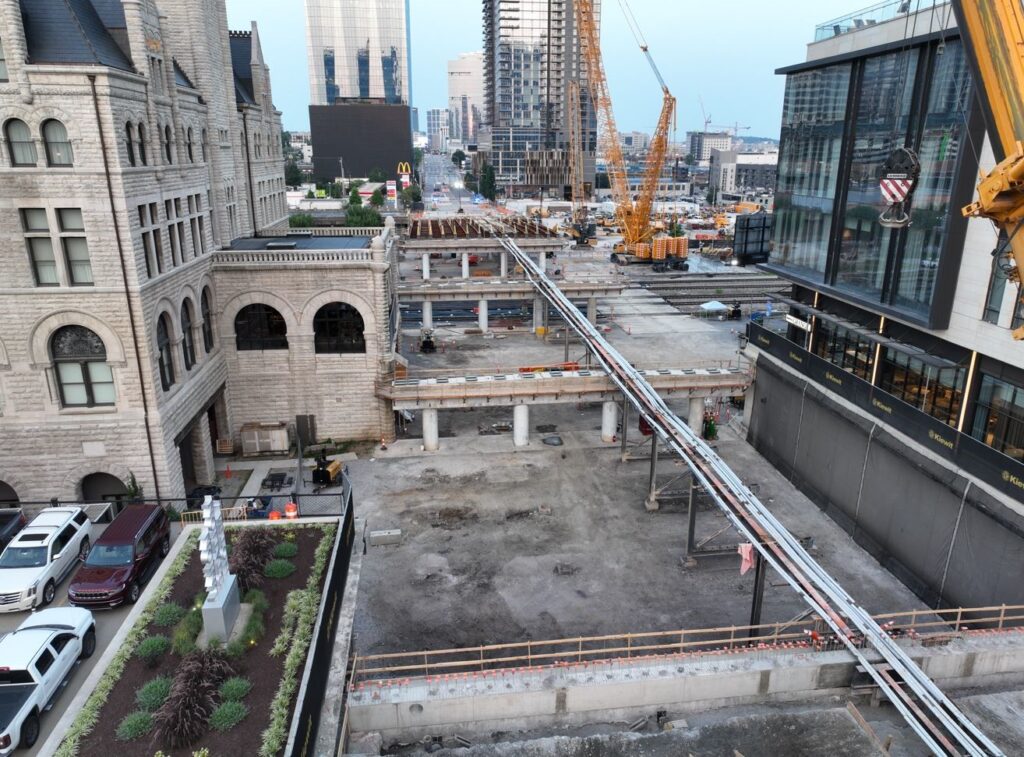Downtown Nashville, Tennessee, draws visitors from around the world. Its famous Broadway Street is a destination for those looking for history or a honky tonk, a local microbrew or a bite of barbecue, or an array of other attractions.
For 75 years, the Broadway Bridge — also known as the State Route 1 (US 431) Broadway Viaduct — has served as a main thoroughfare for vehicles and pedestrians headed downtown.
In recent years, though, despite two rehabilitation projects, it was time for the bridge to be retired. A brand-new replacement bridge project, led by Kiewit for the Tennessee Department of Transportation (TDOT), offers two important benefits: increasing vertical clearance, including over five busy CSX railroad tracks, and accommodating future development in downtown Nashville. Construction on the new bridge began in December 2022 and was completed in October 2023.
Getting a head start
The new, more streamlined design features five spans compared to the previous 17, providing less substructure and more open, usable space. For those who call the downtown residential “Gulch” area home, it’s opened up greater access to green space and bike trails.
Even before the project broke ground, the team was focused on getting ahead of a tight schedule — knowing they would have only an 8-week bridge closure in the summer. That timing also was important because of where the bridge is located.
“With it being downtown, every other piece of real estate around it in the next few years will likely be developed into high-rises or other structures, so TDOT had a small window of opportunity to complete the project,” said Project Manager Mike Svoboda.
During the pre-construction phase, Kiewit worked in collaboration with TDOT, CSX and designer Gresham Smith to develop solutions to the complex technical challenges and unique considerations given the project’s location.
This included identifying early work packages, using innovative construction methods to build the substructure prior to the 8-week closure and minimizing the impact to local stakeholders.
Using the CMGC (Construction Manager/General Contractor) alternative delivery method, the one-team approach from the project’s pre-construction continued throughout the timeline and was a key component of success.
Few surprises, no delays

Working over the busy railroad lines added complexity to the planning. To ensure the process would work smoothly and without delays, Kiewit worked closely with the railroad for more than a year.
Planning Manager Brent Madden and his team prepared hundreds of pages of documents with 3D drawings illustrating each phase of their work, from demolishing large portions of the bridge and getting heavy crane access to the site to moving large girders in, installing rebar and placing concrete.
“At the end of the day, we had 22 separate means-and-methods construction submittals for the railroad — one totaling 300 pages — that had to be reviewed and approved,” said Madden.
“It gave less room for interpretation by doing it this way, rather than relying on a narrative or just relying on 2D plans. We were really showing, in 3D, where all the equipment was, how we were going to access it and even how the workers would be positioned on the job.”
Those drawings were what the railroad and the Kiewit crew had in their hands as the work was performed. The planning meant there were few surprises and no delays during the job.
Accessing tight spaces
Working in tight quarters meant that sometimes, despite planning ahead, the team had to adjust to unique field conditions. Construction Manager Chris Polk found himself in that situation when it was time to set the final girder on span No. 4, located next to the historic Union Station Hotel. There was only half an inch clearance to spare, so he needed to get creative.
“I started looking at it and was thinking, ‘Wow, that doesn’t look like it has very much room,’” Polk said. “So we started pulling string lines and just sort of dissecting it to make sure we had enough room to get it in there. It’s pretty common to have such a tight situation, but I don’t think anybody ever realized how tight it was prior to that moment.”
With help from hotel staff, Polk got permission to access a guest room on the third floor. With his crew on the ground, the team guided the girder into place from an open window.
Another kind of delicate work involved navigating existing AT&T fiber-optic lines attached to the length of the bridge. To demolish the old girder and set the new girder, the team had to carefully work around the lines — something out of the ordinary for this kind of job.
Things got tricky when the team had to pull out the old girder, Polk said.
“You’re talking about inches between AT&T lines, not to mention the torches that are cutting the beam out. It was a slow process to make sure we didn’t damage anything.” Not only did the team do the task cleanly, but they also maintained uninterrupted service to the downtown area.
Tracking by the minute
Kiewit used precast concrete panels for the deck as part of the accelerated bridge construction process. The bridge was raised about two feet over the railroad to meet new construction standards.
There was one unexpected event outside the team’s control. One month prior to the closure, the Southeastern Conference announced it would hold its SEC College Football Kickoff Media Days at one of the hotels adjacent to the construction site, only 10 days into the bridge closure.
“It was the first time it was ever held in Nashville,” said Svoboda. “It was a pretty big deal for the city to make a good showing for them.”
Kiewit consulted their detailed schedule and knew precisely where they needed to be by the time the event would be in town.
“We were tracking those first 10 days by the minute,” said Svoboda. “We rearranged our schedule to focus on just making sure we got the work done adjacent to the hotel and that we were far enough ahead. We didn’t fully shut down, but we shut down any operations that had any kind of noise because they were broadcasting all day.”
‘An outstanding job’
Polk says the job couldn’t have happened without the dedication of the crew, which numbered 110 at the project’s peak. “Hands down, this was some of the best craft we’ve had, and those were the people that made this thing happen,” he said.
Svoboda agrees. “This project really highlights the strength of Kiewit’s people and culture,” he said.
“If you look at the way the job performed on safety, quality and production, it’s hard to believe that a majority of this team had never worked together prior to the closure,” he said. “They really just did an outstanding job on all fronts.”







